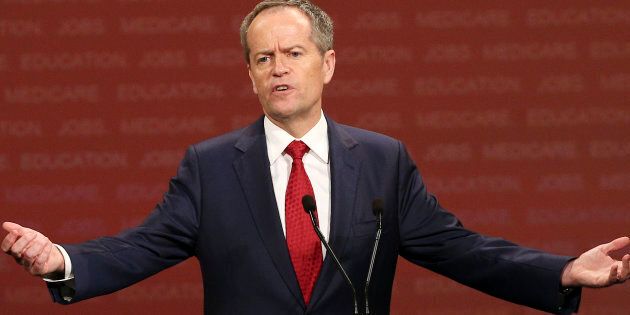
Labor is pretending it had a great victory in nearly winning the federal election last month. It's widely accepted Bill Shorten improved as the long campaign wore on. His party won more seats than expected, and Malcolm Turnbull is on notice.
But Shorten's post-election "victory lap" and the self-congratulations that he and Labor continue to project are misleading. The main benefit of Labor's net seats gain, higher than anticipated at about 13, based on the current count, is to entrench Shorten as leader for a further term. Warded off is a likely challenge from popular Labor figure Anthony Albanese if, say, the figure had been less than 10.
Labor's primary vote, the real test of its support, is really nothing to celebrate. The July 2 primary vote was at least the ALP's lowest since the Chifley era. The ABC's election analyst Antony Green goes further, concluding it was Labor's lowest since the Jack Lang party split of the 1930s.
Labor's overall seat tally in the House of Representatives was pumped up with preferences from the 8–10 percent of primary votes going to the Greens. As the ABC's Green confirms, Labor's position improved only because of the rise of the Greens party, especially in Melbourne. "It is clear that the Liberal vote is static, but Labor is losing votes," Green told me. The trend was not reflected as much in Sydney where Albanese easily defeated a left-of-left Greens candidate in his seat of Grayndler, and where critics claim the Greens are captive to "Fourth International" socialists.
In Melbourne, a Labor heartland essential to the party's future success, it was a different story. Shorten's old Labor mate David Feeney only survived a Greens challenge in the inner-Melbourne seat of Batman with Liberal preferences, and his margin is now wafer thin. The Greens MP Adam Bandt retook neighbouring Melbourne. Besides Batman, the Labor seats of Wills and Melbourne Ports could fall to the Greens next time.
Behind the gloss, Labor has a brand problem, an authenticity problem. Many voters appear to have concluded that -- while not much divides the two major parties -- Labor does not stand for much anymore. It is also beholden to the unions, exemplified best by looking no further than Shorten and his background.
Despite its flaws, and attacks on its impartiality, the Royal Commission into Trade Union Corruption did shine a light on some important issues. Among the most disturbing for Labor hardheads wanting a modern electable party is how unions have operated as a cultural drag on Labor.
The ALP was created in the late 19th century as the parliamentary arm of the union movement. There is no reason to end a formal association, but consider this: union representation has sunk to 11 percent in the private sector where most people work, according to statistics released last October. The actual proportion could be lower -- 10 percent or less -- given the trend and survey lag times.
Unions are now close to losing their critical mass, US-style. Meanwhile, it is becoming absurd that they retain 50 percent control of the ALP, and much more in practical terms. Labor politicians draw their faction numbers to rise through party ranks from unions. Union backing is essential to selecting candidates, setting policy and carving up party funds.
The worst of union culture was obviously seen in the exposure of former Health Services Union officials such as Kathy Jackson, who seemed to use the HSU as a personal plaything. She mustered numbers and exercised power inside the Victorian ALP for many years as a factional buddy of Shorten's. But she went way off the reservation by misusing $1.4 million of union funds to fund a lifestyle of entitlement and excess, according to a Federal Court judgement.
Shorten is not accused of stealing anything. He was exonerated of any "criminal or unlawful" activity by the royal commission. The problem for Shorten, and others like him, is that he remains open to claims of using the Australian Workers Union as a "plaything" when he headed its Victorian branch before entering parliament. He used the AWU as a stepping-stone, devoting enormous energy to using union numbers as the foundation for his rise up the ALP. Shorten still very much relies on the AWU. He is beholden to unions generally.
The absurdity of the union-controlled faction system was played out recently when the ALP's Left split, dumping Kim Carr as one of its nominees for Shorten's post-election Labor shadow ministry. Shorten needed to save Carr to protect his own back because of a power-sharing arrangement with Carr. Andrew Leigh, an unaligned but well-regarded Labor MP, was dumped to save Carr. Shorten then pretended Leigh was saved by giving him a new but officially unrecognised No. 31 spot.
What is the 90 percent non-union voting public meant to think? Surely these shenanigans provide more evidence that union-backed factions count for everything, and merit almost nothing in the modern ALP.
_____________
Brad Norington is the author of Planet Jackson: Power, Greed and Unions, (MUP), available now.